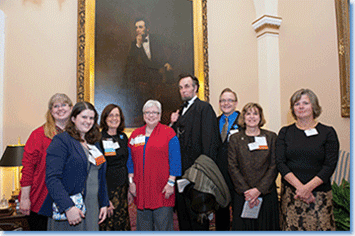News
Museums and the Future of Education
The American Alliance of Museums (AAM) held its annual advocacy event on February 25 and 26 in Washington, DC. With the sequestration deadline very much on the minds of members of Congress, lobbying for steady or increased funding for museums faces serious challenges, and museums have not fared well in recent budget battles. According to Gail Ravnitzky Silberglied, senior director of government relations and advocacy for the American Alliance of Museums, the House-passed budget for fiscal year 2013 explicitly stated that the Institute for Museum and Library Services (IMLS), the National Endowment for the Humanities, and the National Endowment for the Arts are essentially unnecessary. In an attempt to counter these trends, more than 300 museum professionals from around the country travelled to Washington, DC, to express support for the IMLS Office of Museum Services, which awards grants to museums for education, collections care, and digital projects. Advocates also supported preserving tax incentives for charitable giving, an important source of funding for many museums and cultural organizations.
 Elizabeth Merritt, director of the AAM's Center for the Future of Museums, gave the keynote address on museums and the future of education. The museum community has long been dissatisfied with the emphasis on standardized testing in federal legislation such as the No Child Left Behind Act of 2001. Many school districts have cut back on field trips to museums and reduced instruction in history, science, and the arts—subjects enhanced by museum visits. Merritt described the educational model behind the legislation as a relic of the 20th century, based on a model of "manufactured education" in which experts deliver a standardized set of knowledge to students who demonstrate mastery through standardized testing. She warned that in such an environment, museum visits might be seen as a luxury, an optional enhancement to the core curriculum enjoyed primarily by the children of the elite.
Elizabeth Merritt, director of the AAM's Center for the Future of Museums, gave the keynote address on museums and the future of education. The museum community has long been dissatisfied with the emphasis on standardized testing in federal legislation such as the No Child Left Behind Act of 2001. Many school districts have cut back on field trips to museums and reduced instruction in history, science, and the arts—subjects enhanced by museum visits. Merritt described the educational model behind the legislation as a relic of the 20th century, based on a model of "manufactured education" in which experts deliver a standardized set of knowledge to students who demonstrate mastery through standardized testing. She warned that in such an environment, museum visits might be seen as a luxury, an optional enhancement to the core curriculum enjoyed primarily by the children of the elite.
Merritt invited members of the audience to envision a new era of education, one defined by the "Vibrant Learning Grid," based on "self-directed, immersive, passion-based learning." Experts in education are advocating for new ways to teach children creativity, collaboration, and critical thinking through the self-directed, hands-on experiences that museums can provide. Merritt predicted a future in which students would use museums as a resource as they assembled individual learning plans using resources beyond traditional classroom instruction.
According to Merritt, the Henry Ford Academy in Dearborn, Michigan, anticipates this vibrant learning model. The charter school, located inside the Henry Ford Museum and Greenfield Village, is sponsored by the museum, the Ford Motor Company, and the local public school district. It encourages interdisciplinary, experiential education using objects from the museum. An associated website, oninnovation.com, reaches 250,000 students a year with lesson plans on science, history, and technology.
The AAM is a national professional organization that promotes best practices for history, art, science, and youth museums as well as aquariums, zoos, botanical gardens, historic sites, and science and technology centers. The AAM has long operated an accreditation program and a national assessment program. During Advocacy Day, board chair Meme Omogbai (Newark Museum) announced a new effort to reach out to smaller museums through a graduated series of best practices and a pay-what-you-can membership program. She invited participants to sign a pledge of excellence committing their museum to "operate according to national standards and best practices to the best of our abilities and in accordance with our resources." The pledge is meant as a precursor to participation in assessment and recognition programs, such as the ones the AAM conducts, or the American Association for State and Local History's assessment program for small and mid-sized history organizations.
Despite the looming budget cuts, participants left the meeting energized and eager to meet with their congressional representatives to promote the educational, cultural, and economic values of museums in American life.
Debbie Ann Doyle is the AHA's coordinator for committees and meetings. She is also responsible for public history issues.
Tags: History News Public History Museums
Comment
Please read our commenting and letters policy before submitting.






